AP Biology Diagnostic Exam: Section II
FREE-RESPONSE QUESTIONS
Time-1 hour and 30 minutes
(The first 10 minutes is a reading period. Do not begin writing until the 10-minute period has passed.)Questions 1 and 2 are long free-response questions that should require about 20–25 minutes each.Questions 3–6 are short-response questions that should require approximately 8–10 minutes each. Outline form is not acceptable. Answers should be in essay form.
1. Huntington’s disease is a genetic illness that leads to degeneration of the central nervous system. Symptoms typically do not present until between 30 and 40 years of age.
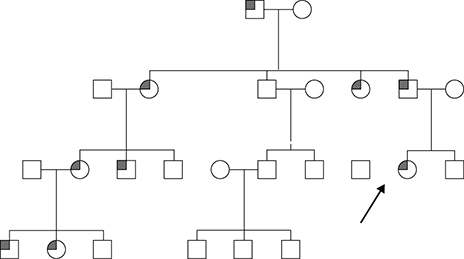
A. The pedigree on the left shows a family with Huntington’s disease in its gene pool. The gray marks indicate the individuals that have Huntington’s disease. Describe the pattern of inheritance shown and explain your reasoning.
B. The couple indicated by the arrow are planning to have a child. Assuming that the husband is healthy, construct a Punnett square to demonstrate the risk of inheritance for their offspring.
C. A randomized trial is conducted to examine whether the drug “Lauder” delays the emergence of symptoms among individuals who carry the genetic traits for inheritance. The age for the first emergence of symptoms is shown in the table provided. Construct an appropriately labeled graph of the average age of the onset of symptoms.
D. Predict what would happen if the family members in the pedigree were to all take the drug Lauder. Justify your prediction.

2. Adequate nutrition intake, along with absorption of nutrients, is necessary for bodily functioning. Through aerobic respiration, eukaryotic organisms conduct cellular respiration in order to transfer organic molecules into usable energy in the form of adenosine triphosphate or ATP.
A researcher is interested in the small and large intestines. Through intensive research, the scientist recognized a new syndrome that significantly reduces nutrient absorption. A new drug is then found and piloted to determine whether the newly developed drug is effective in treating patients with significantly reduced nutrient absorption. Nutrient absorption levels for each patient and the means are shown in the table.

A. Explain how the ATP is produced in the mitochondria during aerobic respiration.
B. Identify the independent and dependent variable in the experiment. Propose one limitation to the study.
C. Construct an appropriately labeled graph of the drug’s effect on nutrient absorption.
D. Identify and explain the effectiveness of the new drug in treating patients with the syndrome.
3. Meiosis is a form of cell division in all sexually reproducing organisms during which the nucleus divides during the production of spores or gametes.
A. Describe and explain TWO aspects of meiosis that contribute to genetic diversity.
B. The mating of two individuals who are closely related is termed consanguineous. Explain how consanguinity would decrease the genetic diversity of offspring. Justify why this decreased diversity would be harmful to the offspring.
4. Scientists have recently discovered that the raccoon population in rural New York communicates using chemical signals via pheromones. The scientists consequently developed four pheromones in an attempt to replicate the natural pheromone. They measured the response time of five raccoons to the developed chemical compounds as an indication of chemical similarity between the developed and natural pheromones. The response times are provided, along with the average response time and standard error of the mean for each developed pheromone.
A. Animals communicate through several mechanisms. Describe TWO methods of communication for animals.
B. Construct an appropriately labeled graph to show the response time for the developed and natural pheromones for the raccoons.
C. Identify which pheromones are most closely aligned to the racoon’s natural producing pheromones.
D. A follow-up study on raccoon pheromone response time is planned to determine whether response to pheromones is an innate or learned response. Response times will be compared between baby raccoons, young raccoons, and adult raccoons. Predict which data will show if the response to pheromones is an innate response.
5. A population of foxes and rabbits in Environment A exhibits the expected predator–prey population curve seen below.
A. Explain the relationship represented by predator and prey in the graph.

B. A bacterial pathogen completely wipes out the population of foxes. Researchers closely watch the rabbit population and notice a new population fluctuation. Identify and explain this change in the population.
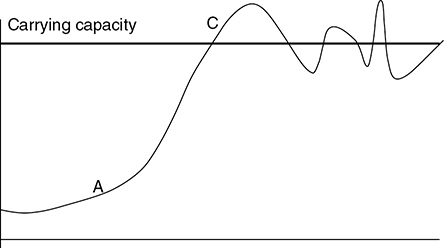
C. Predict the state of the rabbit population in one year. Justify your prediction.
6. A population of wild cats lives in a temperate environment with four seasons. The cats have three main fur colors—white, light brown, and black.
A scientist decides to transplant a random sample of these cats to an environment covered in snow throughout the full year. He notices that as time passes, the cats with one fur color tend to live longer and evade predators better than those with the other two fur colors.
A. Identify the cats with the fur color that is expected to live longer in the new environment. Justify your reasoning.
B. The scientist is also interested in better understanding the evolutionary relationships between the wild cats and several other wild species. Using the data collected on various traits by the scientist, construct a visual representation of the evolutionary relationships.

C. A volcano erupts in the ecosystem that contains the wild cat population. Predict how this would impact the population. Justify your prediction.
 Answers and Explanations
Answers and Explanations
MULTIPLE-CHOICE QUESTIONS
1. C—This question deals with the concept of pH: acids and bases. The pH scale is a logarithmic scale that measures how acidic or basic a solution is. A pH of 4 is 10 times more acidic than a pH of 5. A pH of 6 is 102 or 100 times more basic than a pH of 4, and so on. Therefore, a pH of 10 is 103, or 1,000 times more basic than a pH of 7.
2. D—This question deals with the cytoskeleton of cells. Cell division, cilia, and flagella would be compromised if the microtubules were damaged. Microfilaments, made from actin, are important to muscular contraction. Chitin is a polysaccharide found in fungi.
3. D—This is a prime example of disruptive selection. Take a look at the material from Chapter 11 on the various types of selection. The illustrations there are worth reviewing.
4. B—You have to know this fact. We don’t want them to get you on this one if they ask it. ![]()
5. D—C4 photosynthesis is an adaptive photosynthetic process that attempts to counter the problems that hot and dry weather causes for plants. Be sure that you read about and understand the various forms of photosynthesis for the exam.
6. A—Retroviruses are RNA viruses that carry with them the reverse transcriptase enzyme. When they take over a host cell, they first use the enzyme to convert themselves into DNA. They next incorporate into the DNA of the host, and begin the process of viral replication. The HIV virus of AIDS is a well-known retrovirus.
7. C—Mutualism is the interaction in which both parties involved benefit.
8. A—Phototropism is a plant’s growth in response to light. Auxin is the hormone involved in this process.
9. C—Thigmotropism is a plant’s growth in response to touch.
10. A—This question deals with five types of reactions you should be familiar with for the AP Biology exam. A hydrolysis reaction is one in which water is added, causing the formation of a compound.
11. B—0.50
Let HA = healthy and HC = sickle cell trait

The child will have a 25 percent chance of being healthy, a 50 percent chance of being a carrier, and a 25 percent chance of having sickle cell anemia.
12. A—0.25-
First, determine the risk for one child of inheriting dwarfism. Since this is an autosomal dominant disease, the child needs to inherit only one dominant allele (Dd) to express the disease.

The Punnett square demonstrates that each child has a 50 percent (or ½ chance of inheriting the dominant allele. The couple wants to know the probability that their two children BOTH will have dwarfism. To calculate the probability that both children inherit the dominant allele, multiply the probability of each individual event.
½ * ½ = ¼
Thus, the probability of both children being diagnosed with dwarfism is 25 percent, or ¼
13. B—0.04
There are two main Hardy-Weinberg equations: p + q = 1 AND p2 + 2pq + q2 = 1.
p and q represent the frequency of the dominant and recessive alleles, respectively. p2 and q2 represent the frequency of the homozygous dominant and homozygous recessive phenotypes respectively. Lastly, 2pq represents the frequency of the heterozygous phenotype.
Hardy-Weinberg problems often start by providing information about the recessive phenotype. In this case, we know that the recessive phenotype is in 1 out of every 2,500 mice; we can turn this into a frequency by creating a fraction: 1/2,500 = 0.0004. This frequency is the homozygous recessive phenotype; thus we can equate q2 = 0.0004.
The question asks for the frequency of the heterozygous phenotype (represented by 2pq above). Using our finding q2 = 0.0004, we can determine the value of 2pq.
q2 = 0.0004
So, q = 0.02.
To calculate p, we can use the equation: p + q = 1.
Plugging in q = 0.02 → p + 0.02 = 1 → p = 0.98.
Now to calculate 2pq (frequency of the heterozygous phenotype), plug in the known values: 2(0.98)(0.02) = 0.04. In other words, 4 percent of the population is heterozygous.
14. C—Turner syndrome (XO) is an example of aneuploidy—conditions in which individuals have an abnormal number of chromosomes. These conditions can be monosomies, as is the case with Turner, or they can be trisomies, as is the case with Down, Klinefelter, and other syndromes.
15. A—The selectively permeable membrane is a lipid bilayer composed of phospholipids, proteins, and other macromolecules. Small, uncharged polar molecules and lipids are able to pass through these membranes without difficulty.
16. D—Glycogen is a carbohydrate. The three major types of lipids you should know are fats, phospholipids, and steroids. Cholesterol is a type of steroid.
17. B—This hormone, which is involved in controlling the function of the kidney, is released from the posterior pituitary.
18. A—The stupid phrase we use to remember this classification hierarchy is “Karaoke players can order free grape soda”—kingdom, phylum, class, order, family, genus, and species. This question is sneaky because it requires you to know that a division is the plant kingdom’s version of the phylum. The kingdom is the least specific subdivision, and the species the most specific. Therefore, A is the correct answer.
19. A—Guard cells are the cells responsible for controlling the opening and closing of the stomata of a plant.
20. D—If 9 percent of the population is recessive (ss), then q2 = 0.09. Taking the square root of 0.09 gives us q = 0.30. Knowing as we do that p + q = 1, p + 0.30 = 1, and p = 0.70. The frequency of the heterozygous condition = 2pq = 2(0.30)(0.70) = 42 percent.
21. D—Epistasis exists when a gene at one locus affects a gene at another locus.
22. A—The inputs to the light reactions include light and water. During these reactions, photo-lysis occurs, which is the splitting of H2O into hydrogen ions and oxygen atoms. These oxygen atoms from the water pair together immediately to form the oxygen we breathe.
23. A—0.40
Much of the logic from the previous problem will apply here. To reiterate, there are two main Hardy-Weinberg equations: p + q = 1 AND p2 + 2pq + q2 = 1. p and q represent the frequency of the dominant and recessive alleles, respectively. p2 and q2 represent the frequency of the homozygous dominant and homozygous recessive phenotypes, respectively. Lastly, 2pq represents the frequency of the heterozygous phenotype.
If 36 percent of the population is the recessive phenotype, q2 = 0.36; thus, q = 0.6.
We want the value of p, the dominant allele. We can use: p + q = 1.
With q = 0.6 → p + 0.6 = 1 → p = 0.4.
The frequency of the dominant allele is thus 40 percent.
24. C—Prokaryotes are known for their simplicity. They do not contain a nucleus, nor do they contain membrane-bound organelles. They do have a few structures to remember: cell wall, plasma membrane, ribosomes, and a nucleoid. Lysosomes are found in eukaryotes, not prokaryotes.
25. B—Traits are said to be homologous if they are similar because their host organisms arose from a common ancestor. For example, the bone structure in bird wings is homologous in all bird species.
26. C—Polymerase chain reaction is the high-speed cloning machine of molecular genetics. It occurs at a much faster rate than does cloning.
27. B—Functional groups are a pain in the neck. But you need to be able to recognize them on the exam. Most often, the test asks students to identify functional groups by structure.
28. D—Active transport requires energy. The major types of cell transport you need to know for the exam are diffusion, osmosis, facilitated diffusion, endocytosis, exocytosis, and active transport.
29. D—Homologous chromosomes resemble one another in shape, size, and function. They pair up during meiosis and separate from each other during meiosis I.
30. C—DNA polymerase is the superstar enzyme of the replication process, which occurs during the S phase of the cell cycle in the nucleus of a cell. The process does occur in semiconservative fashion. You should learn the basic concepts behind replication as they are explained in Chapter 10.
31. C—Learn the defense mechanisms well from predator–prey relationships in Chapter 12. They will be represented on the exam.

32. B—A bottleneck is a specific example of genetic drift: the sudden change in allele frequencies due to random events.
33. D—You should learn the list of structures derived from endoderm, mesoderm, and ectoderm. (This could be an easy multiple-choice question for you if you do.)
34. C—12
We are given the observed values in the question prompt. Now you need to calculate the expected phenotypes utilizing a Punnett square. The question stem has provided that the cross is between a heterozygous red-tongued dog (Tt) and a purple-tongued dog (tt).

The Punnett square suggests that this cross would lead to 50 percent red tongue, 50 percent white tongue. Out of 48 dogs, 24 would have a red tongue, and 24 would have a purple tongue.
For two options, the degree of freedom is 1. Since the chi-squared value of 12 is larger than the 5 percent probability value of 3.84, the data does not follow predicted values and is statistically significant. Discard the null hypothesis.
35. A—The Calvin cycle uses a disproportionate amount of ATP relative to NADPH. The cyclic light reactions exist to make up for this disparity. The cyclic reactions do not produce NADPH, nor do they produce oxygen.
36. A—Tay-Sachs disease, cystic fibrosis, and sickle cell anemia are all autosomal recessive conditions. It will serve you well to learn the most common autosomal recessive conditions, X-linked conditions, and autosomal dominant conditions.
37. D—It will serve you well for this exam to be reasonably familiar with biotechnology laboratory techniques. Lab procedures show up often on free-response questions and the later multiple-choice sections of the exam.
38. C—The small intestine hosts the most digestion of the digestive tract.
39. D—This is known as cambium.
40. A—The inner cell mass gives rise to the embryo, which eventually gives rise to the epiblast and hypoblast. The morula is an early stage of development.
41. C—Biomes are annoying and tough to memorize. Learn as much as you can about them without taking up too much time. More often than not there will be two to three multiple-choice questions about them. But you want to make sure you learn enough to work your way through a free-response question if you were to be so unfortunate as to have one on your test.
42. B—Incomplete dominance is the situation in which the heterozygous genotype produces an “intermediate” phenotype rather than the dominant phenotype; neither allele dominates the other.
43. C—The light-dependent reactions occur in the thylakoid membrane. The dark reactions, known as the Calvin cycle, occur in the stroma.
44. D—A J-shaped growth curve is characteristic of exponentially growing populations. That is a characteristic of R-selected strategists.
45. C—Mitosis makes up 10 percent of the cell cycle; the correct order of the stages is prophase, metaphase, anaphase, and telophase; mitosis is not performed by prokaryotic cells; and cell plates are formed in plant cells.
46. B—Thigmotropism, phototropism, and gravi-tropism are the major tropisms you need to know for plants. Thigmotropism, the growth response of a plant to touch, is the least understood of the bunch.
47. A—There are five plant hormones you should know for the exam. Auxin seems to come up the most, but it would serve you well to know the basic functions of all five of them.
48. A—An antigen is a molecule that is foreign to our bodies and acts as a signal molecule that cause an immune response.
49. B—Each NADH is able to produce up to 3 ATP. Each FADH2 can produce up to 2 ATP.
50. B—You have to know the concept of chemi-osmosis for the AP exam. Make sure you study it well.
51. A—Glycolysis is the conversion of glucose into pyruvate that occurs in the cytoplasm and is the first step of both aerobic and anaerobic respiration.
52. D—Fermentation is anaerobic respiration, and it is the process that begins with glycolysis and ends with the regeneration of NAD+.
53. B
54. D
55. A
56. C
57. B—The rate of reaction for an enzyme-aided reaction is best estimated by taking the slope of the constant portion of the moles–time plot.
58. C—They will test your ability to interpret data on this exam. You should make sure that you are able to look at a chart and interpret information given to you. This enzyme does indeed function most efficiently at 20°C. Above and below that temperature, the reaction rate is lower.
59. A—At a pH of 6 and a temperature of 25°C, enzyme 3 is actually LESS efficient than enzyme 2 and MORE efficient than enzyme 1.
60. D—This question requires you to know that a pH below 7 (pH < 7) is acidic and a pH above 7 (pH > 7) is basic. It is true that all three enzymes increase the rate of reaction more when in acidic environments than basic environments.
 Free-Response Grading Outline
Free-Response Grading Outline
1.
A. The pedigree shows a family with Huntington’s disease in its gene pool. The grey marks indicate the individuals that has Huntington’s disease. Describe the pattern of inheritance shown and explain your reasoning.
2 Points – Autosomal dominance inheritance is suspected. Looking at the pedigree, each generation is affected by the illness, which supports dominant as opposed to recessive inheritance. Recessive inheritance would instead show frequent skipping of generations in the pedigree. Autosomal as opposed to sex-linked inheritance is suspected, since males and females are equally affected.
B. The couple indicated by the arrow are planning to have a child. Assuming that the husband is healthy, construct a Punnett square to demonstrate the risk of inheritance for their offspring.
2 Points – To create the Punnett square, we need to determine whether the individual in row 5 is homozygous or heterozygous for the trait. Since one of her parents is unaffected, we can assume she is heterozygous. We are also told that her husband is healthy and, thus, homozygous recessive.

The Punnett square above suggests that each offspring maintains a 50 percent chance of inheriting the disease.
C. A randomized trial is conducted to examine whether the drug “Lauder” delays the emergence of symptoms among individuals who carried the genetic traits for inheritance. The age for first emergence of symptoms is shown in the table provided. Construct an appropriately labeled graph of the average age of the onset of symptoms.
1 Point – Independent and dependent variable correctly plotted
1 Point – Correctly labeled
1 Point – Correctly scaled axis
First, calculate the average age of symptom onset for each of the two conditions:
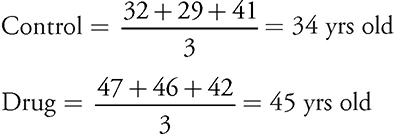
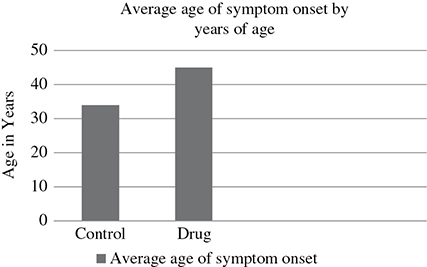
D. Predict what would happen if the family members in the pedigree were to all take the drug Lauder. Justify your prediction.
2 Points – By taking the drug “Lauder,” the Huntington’s condition would still be passed onto the next generation since the condition is genetic and would be passed onto the offspring regardless of the effects of the drug.
2.
A. Explain how the ATP is produced in the mitochondria during aerobic respiration.
2 Points – The electron transport chain creates a proton gradient which sends protons (H+) out of the mitochondrial matrix using the energy carrying NADH and FADH2. This proton is then allowed to flow back down through the ATP synthase and create the ATP necessary for bodily function.
B. Identify the independent and dependent variable in the experiment. Propose one limitation to the study.
1 Point – Independent variable – Exposure to new drug
1 Point – Dependent variable – Nutrient absorption
C. Construct an appropriately labeled graph of the drug’s effect on nutrient absorption.
1 Point – Independent and dependent variable correctly plotted
1 Point – Correctly labeled
1 Point – Correctly scaled axis
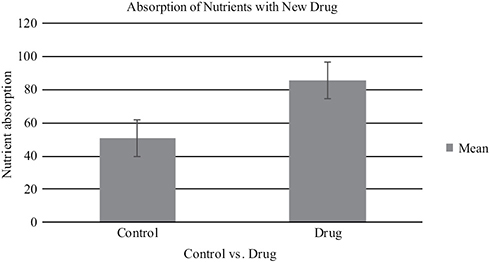
D. Identify and explain the effectiveness of the new drug in treating patients with the syndrome.
1 Point – The study suggests that the new drug has high levels of absorption than the control.
1 Point – There is a statistically significant difference between absorption of nutrients in the control and the new drug.
3.
A. Describe and explain TWO aspects of meiosis that contributes to genetic diversity.
2 Points – Two processes in meiosis that contribute to genetic diversity:
1. Crossing over between homologous chromosomes during prophase I. Complementary DNA strands are exchanged between the chromosomes.
2. Random assortment of homologous chromosomes at the metaphase plate. Homologous chromosomes are divided in half to become haploid cells. It is by chance on which side each pair of chromosomes from the mother and father align.
B. The mating of two individuals who are closely related is termed consanguineous. Explain how consanguinity would decrease the genetic diversity of offspring. Justify why this decreased diversity would be harmful to the offspring.
2 Points – Impact of consanguinity:
1. Genetic diversity would decrease since the mother and father maintain a more similar genetic makeup than a nonconsanguineous pairing.
2. Decreased diversity in this case could prove harmful in the case of recessivetraits. For example, a trait could be rare, but since the mother and father are related, they could be more likely to both be carriers. If both parents are carriers, the probability that the child inherits one or two recessive alleles is increased.
4.
A. Animals communicate through several mechanisms. Describe TWO methods of communication for animals.
2 Points – Communication types include:
• Visual: the use of visual cues to relay meaning. Examples include peacock feather coloring, bared teeth, rolling over on back.
• Tactile: the use of touch to relay meaning. For example, monkeys will groom each other as a sign of affection.
• Auditory: the use of various sounds to relay meaning. For example, the frog chirps to attract a mate.
• Chemical: the use of chemical signals via pheromones. Pheromones play a significant role in animal mating.
B. Construct an appropriately labeled graph to show the response time for the developed and natural pheromones for the raccoons.

C. Identify which pheromones are most closely aligned to the racoon’s natural producing pheromones.
1 Point – Pheromone III demonstrated the fastest mean of the three pheromones tested and thus would be more likely to resemble the natural raccoon pheromones.
D. A follow-up study on raccoon pheromone response time is planned to determine whether response to pheromones is an innate or learned response. Response times will be compared between baby raccoons, young raccoons, and adult raccoons. Predict which data will show if the response to pheromones is an innate response.
1 Point – An innate response is a behavior that does not need to be taught. Thus, if the response to pheromones is innate, the response time of the young raccoons to the pheromones will be similar to the response time of the older raccoons.
5.
A. Explain the relationship represented by predator and prey in the graph.
1 Point – The curve demonstrates that the population concentrations are correlated. The foxes rely on the rabbits for food. As the foxes consume more rabbits, the fox population will grow due to higher supply levels. At some point, the rabbit population will have a higher death rate than birth rate, and thus the population will diminish. Consequently, the fox population will too decrease. Then with decreased predation by the foxes, the rabbit population will be able to rejuvenate.
B. A bacterial pathogen completely wipes out the population of foxes. Researches closely watch the rabbit population and notice a new population fluctuation. Identify and explain this change in the population.
2 Points – With the fox population and predation removed, the rabbits will be able to sustain exponential population growth. At some point, the rabbit population will reach a new carrying capacity, the maximum population size that the environment can support, and thus will level off.
C. Predict the state of the rabbit population in one year. Justify your prediction.
1 Point – The rabbit population will increase over the year, followed by the fox population as there are more rabbits (prey) available.
6.
A. Identify the cats with the fur color that is expected to live longer in the new environment. Justify your reasoning.
2 Points – This is a type of directional selection, where one extreme of the phenotype is “safer” or more adaptive in the environment. In this situation, the environment has snow year around. Thus the cats that have white fur are able to blend into their environment better than the cats with black or brown fur and evade predation more successfully.
B. The scientist is also interested in better understanding the evolutionary relationships between the wild cats and several other wild species. Using the data collected on various traits by the scientist, construct a visual representation of the evolutionary relationships.
1 Point – To create a cladogram, it is often easier to determine outliers for each trait. Beginning with Trait A, Animals 1–3 all have the trait, but Animal 4 does not. Animal 4 also does not have Traits B and C. Next with Trait C, Animals 2 and 3 share the trait, but Animal 1 does not. Lastly with Trait B, only Animal 3 has the trait.

C. A volcano erupts in the ecosystem that contains the wild cat population. Predict how this would impact the population. Justify your prediction.
1 Point – The wild cat population would show an increase in the number of black cats due to their ability to blend into the lava rocks that came from the volcano eruption, increasing their ability to survive.
Scoring and Interpretation
P BIOLOGY DIAGNOSTIC EXAM

AP BIOLOGY
SCORE CONVERSION CHART
